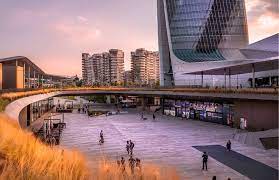City life began
City life began thousands of years ago with the establishment of some of the earliest urban centers in Mesopotamia, Egypt, the Indus Valley, and China. These ancient cities were characterized by complex societies with distinct social hierarchies, trade networks, and monumental architecture. Life in these cities often revolved around religious practices, governance, and early forms of commerce.
Medieval Cities
In medieval Europe, cities grew as centers of trade and commerce. The rise of feudalism and the Church significantly influenced city life, with a focus on craft guilds, market trade, and communal religious activities. Urban areas in this period often had fortified walls, narrow streets, and were bustling with traders, artisans, and clerks The Industrial Revolution marked a significant transformation in city life. The mass migration from rural to urban areas led to the rapid expansion of cities, which became centers of industry, innovation, and social change. This period saw the rise of working-class neighborhoods, industrial pollution, and significant socioeconomic stratification.
Economic Opportunities
In contemporary cities, economic opportunities are a major draw. Urban areas typically offer diverse employment options across various sectors, from finance and technology to creative industries and service-oriented roles. This economic diversity attracts individuals seeking career advancement, entrepreneurial ventures, and higher living standards .Modern cities are melting pots of cultural diversity. This diversity enriches city life through a variety of cultural festivals, cuisines, art, and entertainment options. Multiculturalism fosters a dynamic social environment, where different traditions, languages, and practices coexist and contribute to a city’s vibrant character.
Urban Infrastructure
Cities today are equipped with advanced infrastructure, including public transportation systems (buses, subways, and trams), healthcare facilities, educational institutions, and recreational spaces. Urban planning focuses on improving accessibility, sustainability, and quality of life, addressing issues like traffic congestion, pollution, and green spaces. City life often involves a blend of anonymity and community. While urban settings can offer a sense of individuality and freedom, they also foster diverse communities and social networks. Residents may find a sense of belonging through local events, neighborhoods, and shared interests.
Social Stratification
Urban environments exhibit various forms of social stratification. Cities often have distinct socioeconomic neighborhoods, with disparities in housing quality, access to services, and overall living conditions. Gentrification can also reshape social dynamics, affecting long-term residents and altering the character of neighborhoods. City dwellers experience a unique lifestyle characterized by fast-paced routines, convenience, and a broad range of amenities. Daily life in the city might include navigating busy streets, accessing 24-hour services, and participating in a variety of cultural and social activities. The pace of life can be both exhilarating and overwhelming, depending on one’s perspective.
Housing and Cost of Living
One of the significant challenges in city life is the high cost of living, particularly regarding housing. Urban areas often experience housing shortages and rising property prices, leading to affordability issues for many residents. The demand for real estate can result in crowded living conditions and increased rent prices. Cities face various environmental challenges, such as air and noise pollution, waste management, and the urban ban heat island effect. These issues can impact residents’ health and quality of life. Efforts to create sustainable urban environments involve green building practices, improved public transportation, and initiatives to enhance air and water quality.
Safety and Security
Urban areas can present safety and security concerns, including crime and emergency response issues. Cities invest in policing, surveillance, and community safety programs to address these challenges. Personal safety in the city can vary widely based on location, socioeconomic factors, and individual circumstances. The concept of smart cities is gaining traction, with a focus on integrating technology to improve urban living. This includes using data analytics, IoT (Internet of Things), and AI (Artificial Intelligence) to enhance city services, reduce traffic congestion, and create more efficient and sustainable urban environments.
Urban Resilience
The future of city life will also involve building resilience against climate change and other global challenges. Cities are increasingly focusing on sustainable practices, disaster preparedness, and adaptive strategies to ensure long-term livability and resilience. The rise of remote work is reshaping urban life, potentially altering commuting patterns, and influencing urban design. As more people work from home, cities might see changes in office space usage, transportation needs, and residential preferences.
